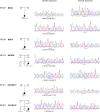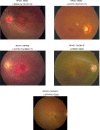Mutation analysis in 129 genes associated with other forms of retinal dystrophy in 157 families with retinitis pigmentosa based on exome sequencing
- PMID: 25999675
- PMCID: PMC4415588
Mutation analysis in 129 genes associated with other forms of retinal dystrophy in 157 families with retinitis pigmentosa based on exome sequencing
Abstract
Purpose: Mutations in 60 known genes were previously identified by exome sequencing in 79 of 157 families with retinitis pigmentosa (RP). This study analyzed variants in 129 genes associated with other forms of hereditary retinal dystrophy in the same cohort.
Methods: Apart from the 73 genes previously analyzed, a further 129 genes responsible for other forms of hereditary retinal dystrophy were selected based on RetNet. Variants in the 129 genes determined by whole exome sequencing were selected and filtered by bioinformatics analysis. Candidate variants were confirmed by Sanger sequencing and validated by analysis of available family members and controls.
Results: A total of 90 candidate variants were present in the 129 genes. Sanger sequencing confirmed 83 of the 90 variants. Analysis of family members and controls excluded 76 of these 83 variants. The remaining seven variants were considered to be potential pathogenic mutations; these were c.899A>G, c.1814C>G, and c.2107C>T in BBS2; c.1073C>T and c.1669C>T in INPP5E; and c.3582C>G and c.5704-5C>G in CACNA1F. Six of these seven mutations were novel. The mutations were detected in five unrelated patients without a family history, including three patients with homozygous or compound heterozygous mutations in BBS2 and INPP5E, and two patients with hemizygous mutations in CACNA1F. None of the patients had mutations in the genes associated with autosome dominant retinal dystrophy.
Conclusions: Only a small portion of patients with RP, about 3% (5/157), had causative mutations in the 129 genes associated with other forms of hereditary retinal dystrophy.
Figures



Similar articles
-
Exome sequencing identifies RDH12 compound heterozygous mutations in a family with severe retinitis pigmentosa.Gene. 2013 Oct 10;528(2):178-82. doi: 10.1016/j.gene.2013.07.021. Epub 2013 Jul 27. Gene. 2013. PMID: 23900199
-
Mutations of 60 known causative genes in 157 families with retinitis pigmentosa based on exome sequencing.Hum Genet. 2014 Oct;133(10):1255-71. doi: 10.1007/s00439-014-1460-2. Epub 2014 Jun 18. Hum Genet. 2014. PMID: 24938718
-
Exome sequencing of 47 chinese families with cone-rod dystrophy: mutations in 25 known causative genes.PLoS One. 2013 Jun 11;8(6):e65546. doi: 10.1371/journal.pone.0065546. Print 2013. PLoS One. 2013. PMID: 23776498 Free PMC article.
-
Toward an elucidation of the molecular genetics of inherited retinal degenerations.Hum Mol Genet. 2017 Aug 1;26(R1):R2-R11. doi: 10.1093/hmg/ddx185. Hum Mol Genet. 2017. PMID: 28510639 Free PMC article. Review.
-
OR2W3 sequence variants are unlikely to cause inherited retinal diseases.Ophthalmic Genet. 2016 Dec;37(4):366-368. doi: 10.3109/13816810.2015.1081252. Epub 2016 Feb 18. Ophthalmic Genet. 2016. PMID: 26891008 Review.
Cited by
-
Diverse Genetic Landscape of Suspected Retinitis Pigmentosa in a Large Korean Cohort.Genes (Basel). 2021 Apr 30;12(5):675. doi: 10.3390/genes12050675. Genes (Basel). 2021. PMID: 33946315 Free PMC article.
-
Application of targeted panel sequencing and whole exome sequencing for 76 Chinese families with retinitis pigmentosa.Mol Genet Genomic Med. 2020 Mar;8(3):e1131. doi: 10.1002/mgg3.1131. Epub 2020 Jan 20. Mol Genet Genomic Med. 2020. PMID: 31960602 Free PMC article.
-
Concomitant Calcium Channelopathies Involving CACNA1A and CACNA1F: A Case Report and Review of the Literature.Genes (Basel). 2023 Feb 3;14(2):400. doi: 10.3390/genes14020400. Genes (Basel). 2023. PMID: 36833327 Free PMC article.
-
Genetic dissection of non-syndromic retinitis pigmentosa.Indian J Ophthalmol. 2022 Jul;70(7):2355-2385. doi: 10.4103/ijo.IJO_46_22. Indian J Ophthalmol. 2022. PMID: 35791117 Free PMC article. Review.
-
Utilization of automated cilia analysis to characterize novel INPP5E variants in patients with non-syndromic retinitis pigmentosa.Eur J Hum Genet. 2024 Nov;32(11):1412-1418. doi: 10.1038/s41431-024-01627-6. Epub 2024 May 28. Eur J Hum Genet. 2024. PMID: 38806661 Free PMC article.
References
-
- Hartong DT, Berson EL, Dryja TP. Retinitis pigmentosa. Lancet. 2006;368:1795–809. - PubMed
Publication types
MeSH terms
Substances
LinkOut - more resources
Full Text Sources

